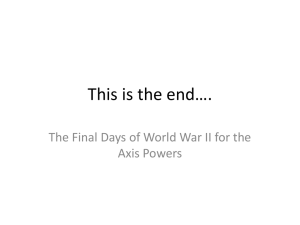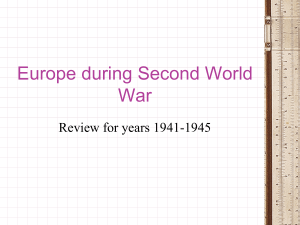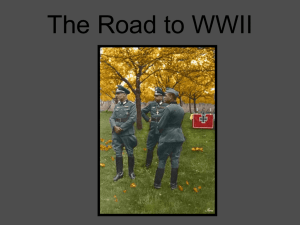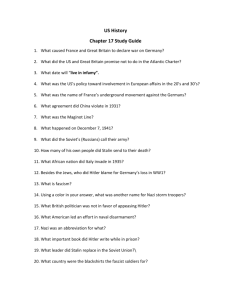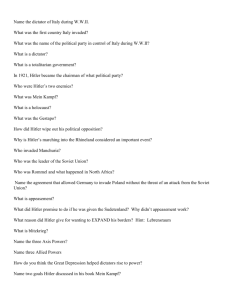Totalitarianism and the Outbreak of World War II
advertisement
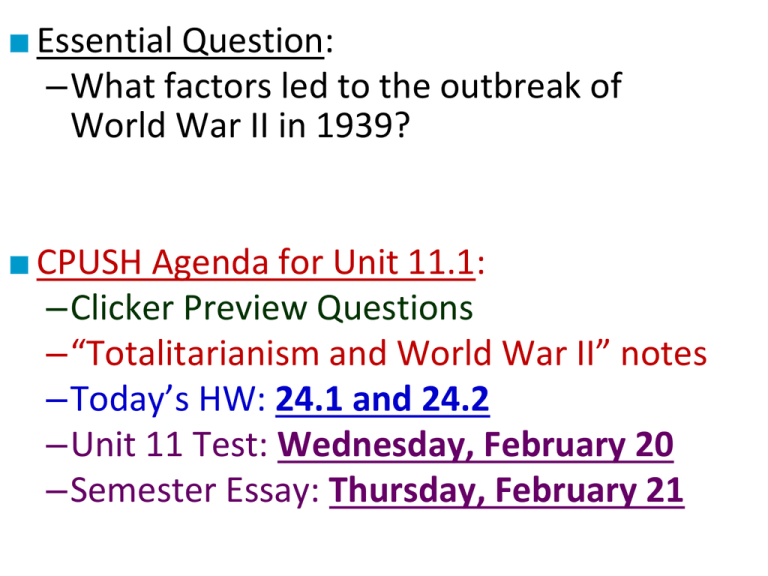
■ Essential Question: –What factors led to the outbreak of World War II in 1939? ■ CPUSH Agenda for Unit 11.1: –Clicker Preview Questions –“Totalitarianism and World War II” notes –Today’s HW: 24.1 and 24.2 –Unit 11 Test: Wednesday, February 20 –Semester Essay: Thursday, February 21 WWI was not the “war to end all wars” because events from 1919 to 1939 led to another world war The punishing terms of Huge reparations slowed the Treaty of Versailles led Germany’s ability to to resentment in Germany rebuild after the war Britain, France, and other members of the League of Nations wanted to avoid another war The Great Depression meant no American money for rebuilding and a world-wide depression in Europe Germany inflation was so bad, money was worthless; German children play with stacks of money In the 1920s and 1930s, nationalism increased and totalitarian dictators came to power Totalitarian leaders came to power by promising jobs and promoting nationalism Dictators controlled all aspects of the nation by eliminating rivals, denying liberties, using censorship, secret police After Vladimir Lenin’s death in 1924… …Joseph Stalin gained control of the Soviet Union Stalin was Communist and seized all property, farms, factories in order to control the economy and create equality He used a secret police and the Great Purge to eliminate rivals Stalin’s Five Year Plans transformed the Soviet Union into an industrial and military power by 1939 Not all totalitarian dictators were Communists… Fascist governments were controlled by dictators who demanded loyalty from citizens Fascists did not offer democracy and used one party to rule the nation Unlike Communists, fascists believed people could keep their property …In Italy, Germany, and Spain, people turned to an extremely nationalist gov’t called fascism In Italy, Benito Mussolini’s Fascist Party seized power by promising to revive the economy, rebuild the military, and create a new Roman Empire Mussolini’s “march on Rome” The “Blackshirts” The Nazis were a fascist group in Germany that wanted to overthrow the disloyal Weimar Republic Hitler was impressed by Mussolini and used many of his ideas to make the Nazi Party strong in Germany Adolf Hitler was an early Nazi recruit and quickly rose to power in the party Hitler’s Mein Kampf outlined his plans for Germany He wrote that Germans were members of a master race called Aryans and all non-Aryans were inferior He declared that Germans needed lebensraum (living space) and should conquer Eastern Europe and Russia He called the Treaty of Versailles an outrage and vowed to regain land taken from Germany after the war In 1933, Hitler was named chancellor (prime minister) of Germany and used his power to become dictator Hitler put Germans to work by building factories, highways, weapons, and increasing the military He created the gov’t protection squad called the SS and a secret police called the Gestapo to eliminate rivals and control all aspects of Germany In 1935, Hitler began a series of anti-Semitic laws called the Nuremburg Laws that deprived German Jews of the rights of citizens, forbade mixed Jewish marriages, and required Jews to wear a yellow star In 1938, Hitler ordered Kristallnacht (Night of Broken Glass) a series of attacks on Jewish synagogues and businesses After WWI, Japan was the strongest nation in Asia and was ready to conquer new lands to provide resources for Japanese industry Emperor Hirohito, gave full control of the Japanese military to Hideki Tojo who served as a military dictator In the 1930s, Japan, Italy, and Germany began aggressively expanding in Africa, Asia, and Europe Japan invaded Manchuria in 1931 and mainland China in 1937 In 1935, Mussolini began his campaign to create an Italian Empire by invading Ethiopia Ethiopian soldiers defending their country from the Italian military The League of Nations condemned Japan and Italy but did nothing to stop the attacks in order to maintain world peace The failure of the League of Nations to stop Italy or Japan, encouraged Hitler to expand Germany too By 1936, Hitler had expanded the German military and moved troops into the Rhineland In 1938, Germany annexed Austria and the Sudetenland In 1939, Hitler invaded Czechoslovakia The League of Nations used appeasement to avoid war with Germany, Italy, and Japan Mussolini Hitler Chamberlain At the Munich Conference, 1938 In 1939, Hitler demanded the return on Poland to Germany but wanted to avoid a war with the USSR Stalin and Hitler agreed to the Nazi-Soviet Nonaggression Pact, promising to divide Poland and to never to attack each other On September 1, 1939, Germany invaded Poland On September 3, 1939, Britain and France declared war on the Axis Powers (Germany, Italy, and Japan) and World War II began When World War II began, German blitzkrieg tactics led to the conquest of Poland, Denmark, Norway, Netherlands, Belgium, France, the Balkans …the Axis Powers seized North Africa In 1941, Hitler broke the Nazi-Soviet Pact and invaded the Soviet Union By 1941, Germany and Italy controlled most of Europe and North Africa Meanwhile, Japan conquered new territories in Asia and threatened Guam and the Philippines From 1939 to 1941, the United States remained neutral, but not isolated, from the global conflict Closure Activity ■On your map, label the following: –The 3 main Axis Powers –The territories under the control of the Axis Powers by 1942 ■On your timeline, identify the 5 most important events that contributed to World War 2; For each event, provide a brief summary & an image



